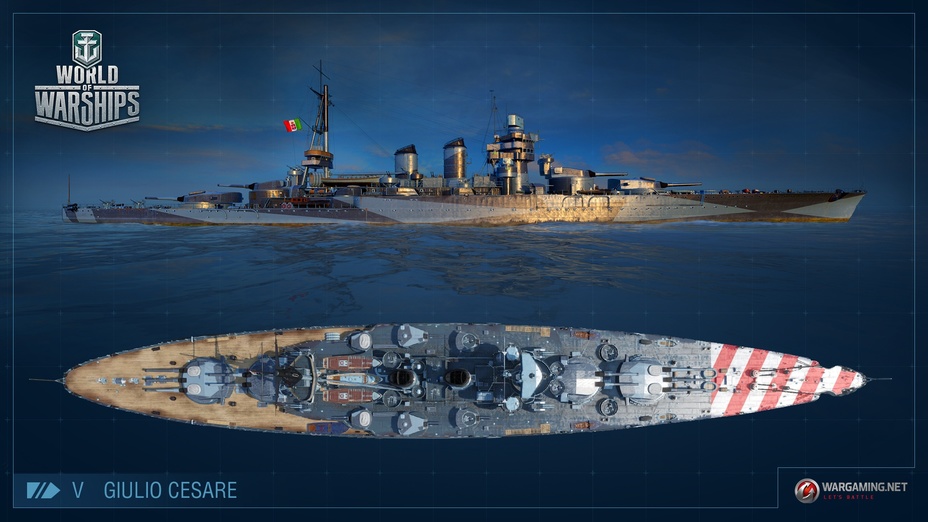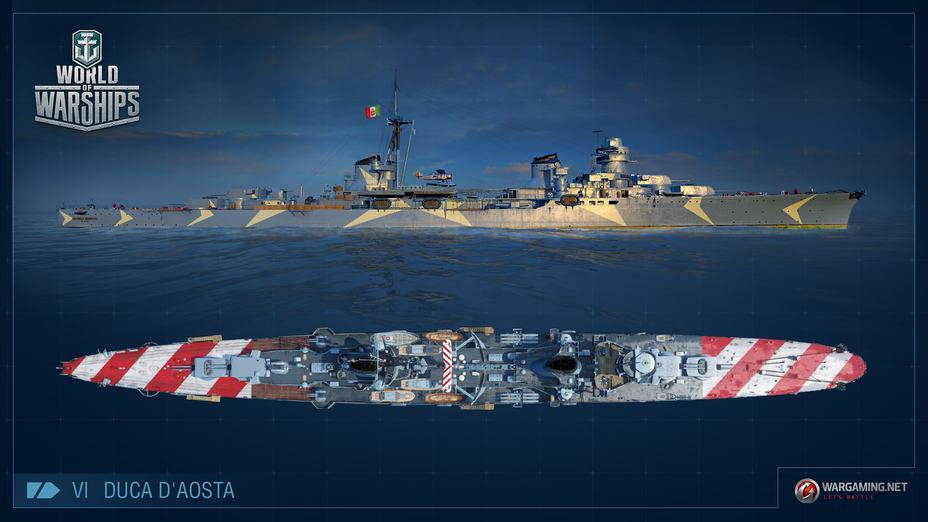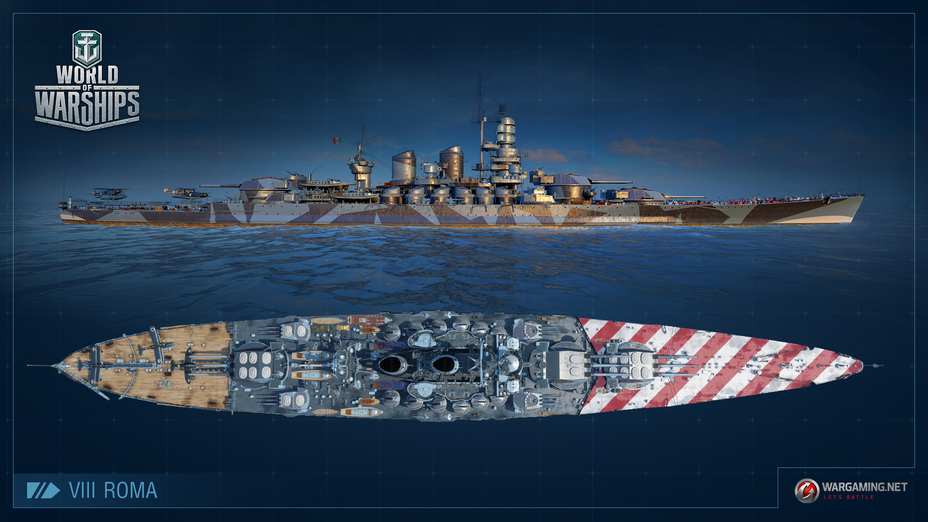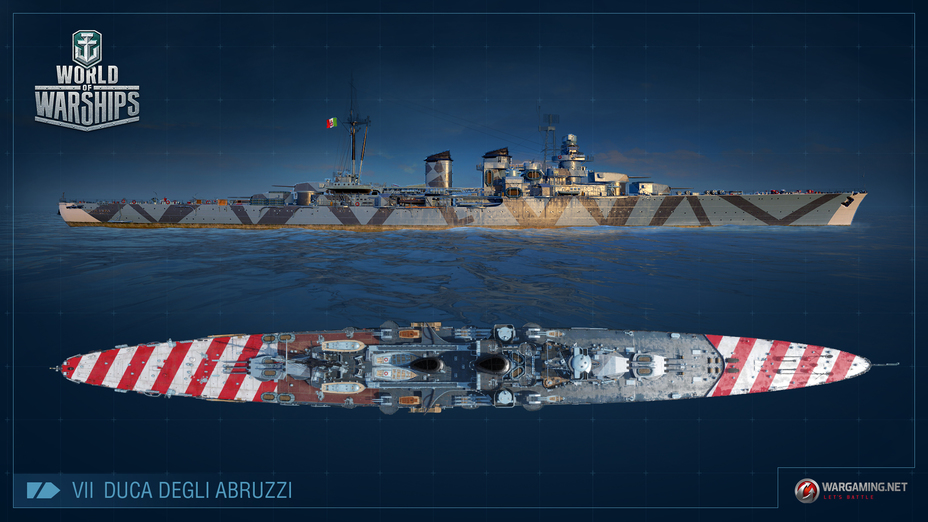Like most maritime powers, Regia Marina did not pay much attention to the concealment coloring of warships during the inter-war period. Until World War II, Italian ships were painted according to the standard adopted back in 1929.
This pattern dictated that the part of the hull above the waterline and vertical surfaces were painted with a light ash grey color (Grigio Cenerino). The underwater part of large ships' hulls was painted dark green (Verde Scuro), while the underwater part of destroyers' hulls was brick red (Rosso Mattone). The metal parts of the decks were dark grey with a metallic traces (Grigio Ferro), while the cover of wooden decks remained unpainted. The waterline, top part of the main mast, and canopies of the funnels were black.
With the outbreak of the war, the picture changed. After Italian aircraft mistakenly bombed their own ships in the Battle of Calabria of July 1940, identification marks were introduced. To simplify identification of allied warships from the air, alternating red and white stripes were applied on the tank or quarterdeck of all the ships. The upper surfaces of ship-borne seaplanes were painted in a similar manner.
The identification zone on destroyers and torpedo boats was spread up to the fore-end breakwater, while on larger ships it spread only until the fore-end turret. Littorio-class battleships were the only exception, with each of such type of battleship having their own special features. Littorio and Vittorio Veneto had identification strips that ended before reaching the fore-end turret. Besides this, Vittorio Veneto's wooden quarterdeck had lead-grey coloring with diagonal strips. Littorio received also this coloring on her stern much later—at the end of 1941. Battleship Roma's identification coloring at the bow reached the second breakwater, while her aft was not painted at all. The identification stripes of Littorio and Vittorio Veneto were painted over in early 1943, unlike those of Roma, which remained on the ship until she was sunk.

The light grey coloring of Italian peacetime ships, barely visible in cloudy weather, looked almost white and was remarkably visible from afar when the weather was clear and sunny. As a result, in 1940, work on the creation of concealment camouflage patterns began. Finally, on January 18, 1941, the Naval Ministry issued a decree introducing camouflage paint for warships.
The first trials were conducted on cruisers Fiume and Emanuele Filiberto Duca d'Aosta, undergoing repairs in La Spezia at the time. On January 21, the Ministry sent two samples of experimental camouflage schemes, developed on the basis of the patterns used during World War I. Duca d'Aosta received bright yellow-green divergent wedges intended to impede enemy observers from determining elements of the ship's movement. The hull and superstructures were painted with a deep dark grey. This scheme was called «double fish bone». Later, this type of camouflage was deemed ineffective, and all ships with it were repainted. The scheme used for Fiume—dark, vertically arranged strips of irregular shapes over the hull and superstructures—proved to be more successful. Gorizia—the only ship of the series that survived the Battle of Cape Matapan—in March 1942, received a type of concealment painting called Claudus (named after the seascape painter who designed it), introduced by the order of February 15. It had a rather sophisticated pattern with «jagged» edges. Dark grey, light grey, and dirty white (Bianco Sporco Opaco) colors were initially used, but in summer, the white areas were painted over with light grey. The camouflage pattern remained in use until the end of the war, as can be seen from the pictures of a submerged ship taken in 1945 in La Spezia. In April 1942, Trento was also painted according to the Claudus scheme, but instead of dark grey, this cruiser had black.

In October 1941, a new two-color scheme was tested. Light ash grey (Grigio Cenerino) was still the main color, with wide dark grey stripes applied on top of it. The fore- and aft-ends had dirty white coloring to conceal the size of the waves made by the ship and, thus, to make it harder for observers to determine her speed.
On December 29, 1941, this scheme was officially approved as a standard. However, it was recommended when possible, to apply a variety of drawings to different ships, and even to different sides of the same ship. The dark stripes needed to have irregular shapes, avoiding horizontal, vertical, or parallel lines. During 1942, this pattern was applied to all their ships, except for a few that had already been painted according to the Claudus scheme. In June 1942, Trieste received a similar scheme, but with several light green areas, including the ship's ends. In July however, these light green areas were repainted with dirty white coloring and by the end of August they became ash-grey.
In the initial period of the war, another Claudus scheme was quite popular—a combined fragmentation painting based on broken polygons, colored with two contrasting shades of grey. In some cases, one or two additional colors—primarily light blue (Azzurro) and dirty white—could be added to the hull, ends, and superstructures.

A similar pattern—but with three colors—was used in another scheme that had smooth rounded stripes. In the previous camouflage pattern, light colors could be applied to any part of the ship, while in this scheme only the fore- and aft-ends had light tones. Apparently, in this case, a false perspective method was used, similar to the camouflage patterns of Kriegsmarine ships.
During her repair in Genoa in early 1942, Bolzano carried for some time a camouflage that impeded her detection from the air, but before returning to service, she was repainted using the standard scheme. As with other cruisers, the dirty white areas were painted over with ash grey coloring at the end of August of 1942.

Camouflage patterns differed from cruiser to cruiser, and even from side to side of the same ship. All vertical surfaces were concealed: sides, superstructures, funnels, and turrets. The main purpose of camouflages was to make it harder to determine the class of a ship, her course and speed. These measures seemed important for the Italians, mostly with a view to reducing the threat posed by British submarines active in the Mediterranean. Nevertheless, concealing camouflage patterns could not protect Trento or Bolzano from being hit by torpedoes launched by British submarines, so the measure cannot be deemed to have been effective.
When Italy joined the Allies, concealment camouflage coloring was abolished, and Italian ships were repainted according to the standard scheme used on Allied ships—a dark grey hull with light grey superstructures.




